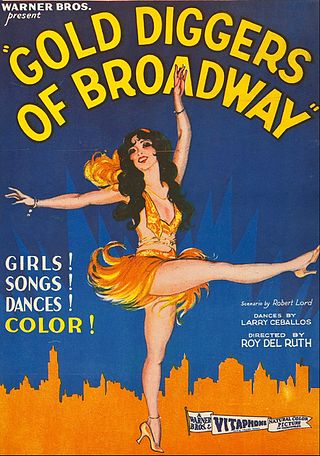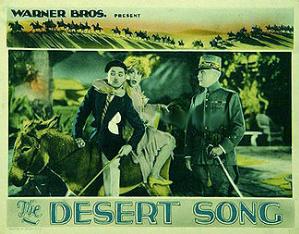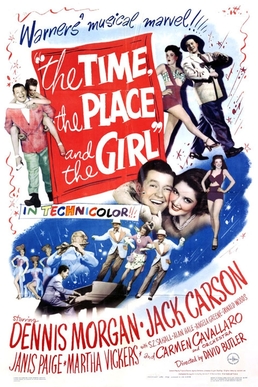
The Hollywood Revue of 1929, or simply The Hollywood Revue, is a 1929 American pre-Code musical comedy film released by Metro-Goldwyn-Mayer. It was the studio's second feature-length musical, and one of their earliest sound films. Produced by Harry Rapf and Irving Thalberg and directed by Charles Reisner, it features nearly all of MGM's stars in a two-hour revue that includes three segments in Technicolor. The masters of ceremonies are Conrad Nagel and Jack Benny.

The Broadway Melody, also known as The Broadway Melody of 1929, is a 1929 American pre-Code musical film and the first sound film to win an Academy Award for Best Picture. It was one of the early musicals to feature a Technicolor sequence, which sparked the trend of color being used in a flurry of musicals that would hit the screens in 1929–1930. Today, the Technicolor sequence survives only in black and white. The film was the first musical released by Metro-Goldwyn-Mayer and was Hollywood's first all-talking musical.

Yankee Doodle Dandy is a 1942 American biographical musical film about George M. Cohan, known as "The Man Who Owned Broadway". It stars James Cagney, Joan Leslie, Walter Huston, and Richard Whorf, and features Irene Manning, George Tobias, Rosemary DeCamp, Jeanne Cagney, and Vera Lewis. Joan Leslie's singing voice was partially dubbed by Sally Sweetland.
Harry Akst was an American songwriter, who started out his career as a pianist in vaudeville accompanying singers such as Nora Bayes, Frank Fay and Al Jolson.

Gold Diggers of Broadway is a 1929 American pre-Code musical comedy film directed by Roy Del Ruth and starring Winnie Lightner and Nick Lucas. Distributed by Warner Bros., the film is the second all-talking, all-Technicolor feature-length film.

The Show of Shows is a 1929 American pre-Code musical revue film directed by John G. Adolfi and distributed by Warner Bros. The all-talking Vitaphone production cost almost $800,000 and was shot almost entirely in Technicolor.

Song of the West is a 1930 American Pre-Code musical western film produced by Warner Bros., and photographed entirely in Technicolor. It was based on the 1928 Broadway musical Rainbow by Vincent Youmans (music), Oscar Hammerstein II (lyrics) and Laurence Stallings (book). It starred John Boles, Joe E. Brown and Vivienne Segal, and was the first all-color all-talking feature to be filmed entirely outdoors.

Sally is a 1929 American Pre-Code film. It is the fourth all-sound, all-color feature film made, and it was photographed in the Technicolor process. It was the sixth feature film to contain color that had been released by Warner Bros.; the first five were The Desert Song (1929), On with the Show! (1929), Gold Diggers of Broadway (1929), Paris (1929) and The Show of Shows (1929).. Although exhibited in a few theaters in December 1929, Sally entered general release on January 12, 1930.
"Am I Blue?" is a 1929 song composed by Harry Akst (music) and Grant Clarke (lyrics), then featured in four films that year, most notably with Ethel Waters in the movie On with the Show. It has appeared in 42 movies, most recently Funny Lady, The Cotton Club and Downton Abbey: A New Era, and has become a standard covered by numerous artists. As a work from 1929 with its copyright renewed it will enter the public domain on January 1, 2025.

Song of the Flame is a 1930 American pre-Code musical film photographed entirely in Technicolor. Based on the 1925 operetta of the same name, the film features a screenplay by Gordon Rigby adapted from the musical book written by Oscar Hammerstein II and Otto A. Harbach for the operetta. The movies also features many of the songs from the operetta which used lyrics by Hammerstein and Orbach and music by George Gershwin and Herbert Stothart. The film was produced and distributed by First National Pictures. It was the first color film to feature a widescreen sequence, using a process called Vitascope, the trademark name for Warner Bros.' widescreen process. The film, based on the 1925 Broadway musical of the same name, was nominated for an Academy Award for Sound Recording. It is part of the tradition of operetta films, popular at the time.

Manhattan Parade is a 1931 American pre-Code musical comedy film photographed entirely in Technicolor. It was originally intended to be released, in the United States, early in 1931, but was shelved due to public apathy towards musicals. Despite waiting a number of months, the public proved obstinate and the Warner Bros. reluctantly released the film in December 1931 after removing all the music. Since there was no such reaction to musicals outside the United States, the film was released there as a full musical comedy in 1931.

The Desert Song is a 1929 American pre-Code operetta film directed by Roy Del Ruth and starring John Boles, Carlotta King, Louise Fazenda, and Myrna Loy. It was photographed partly in two-color Technicolor, the first film released by Warner Bros. to include footage in color. The film included a 10-minute intermission during which music was played.

No, No, Nanette is a 1930 American pre-Code musical comedy film with Technicolor sequences that was directed by Clarence G. Badger and released by First National Pictures. It was adapted from the play of the same title by Otto A. Harbach and Frank Mandel. No, No, Nanette was a popular show on Broadway, running for 321 performances, and was produced and directed by Harry Frazee.

Paris is a 1929 American pre-Code musical comedy film, featuring Irène Bordoni. It was filmed with Technicolor sequences: four of the film's ten reels were originally photographed in Technicolor.

Mammy (1930) is an American pre-Code musical comedy-drama film with Technicolor sequences, released by Warner Bros. The film starred Al Jolson and was a follow-up to his previous film, Say It with Songs (1929). Mammy became Al Jolson's fourth feature, following earlier screen efforts as The Jazz Singer (1927), The Singing Fool (1928) and Say It with Songs (1929). The film relives Jolson's early years as a minstrel man. The songs were written by Irving Berlin, who is also credited with the original story titled Mr. Bones.

The Hard Way is a 1943 Warner Bros. musical drama film starring Ida Lupino, Dennis Morgan, and Joan Leslie. Directed by Vincent Sherman, it is based on a story by Irwin Shaw which was reportedly based on Ginger Rogers' relationship with her first husband Jack Pepper and her mother Lela.
Is Everybody Happy? (1929) is an American pre-Code musical film starring Ted Lewis, Alice Day, Lawrence Grant, Ann Pennington, and Julia Swayne Gordon, directed by Archie Mayo, and released by Warner Bros. The music for the film was written by Harry Akst and Grant Clarke, except for "St. Louis Blues" by W. C. Handy and "Tiger Rag". The film's title comes from Lewis's catchphrase "Is everybody happy?"

My Man is a 1928 black and white sound part-talkie American comedy-drama musical film directed by Archie Mayo starring Fanny Brice and featuring Guinn "Big Boy" Williams. In addition to sequences with audible dialogue or talking sequences, the film features a synchronized musical score and sound effects along with English intertitles. The soundtrack was recorded using the Vitaphone sound-on-disc system.

Broadway Babies, aka Broadway Daddies (UK) and Ragazze d'America (Italy), is a 1929 all-talking Pre-Code black and white American musical film produced and distributed by First National Pictures, a subsidiary of Warner Brothers. The film was directed by Mervyn LeRoy and starred Alice White and Charles Delaney. This was White's first sound film with dialogue.

The Time, the Place and the Girl is a 1946 American Technicolor musical comedy film directed by David Butler and starring Dennis Morgan, Jack Carson, Janis Paige and Martha Vickers. The film was produced and distributed by Warner Brothers. It is unrelated to the 1929 film The Time, the Place and the Girl.



















